Transform 16 Masterclass: Deconstructing Delight with Jared Spool & Dana Chisnell
With the Early Bird prices for Transform 17 closing tomorrow (Fri 3/3), it’s a good time to remind you that the event is more than just a day of talks. Our Masterclass this year is divided into two workshops, and should be a full-on day with two experts.
Attendees of last year’s workshop with Jared Spool and Dana Chisnell will attest that it was a remarkable day: intense, funny, insightful, sometimes shocking (some of their poor UX examples!) and entirely absorbing.
Here’s how we described it in Wrap magazine.
Deconstructing Delight
Jared Spool and Dana Chisnell
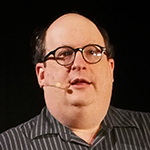

Masterclass – Canberra 18 May, Sydney 23 May
Jared Spool and Dana Chisnell each have a rich history of working in the usability field, and it shows in their poise as speakers, their confidence in their research and the way they each create a detailed structure that others can draw on and use.
Above all, what shines through is their intelligence, which informs the empathy that underpins their approach to User Experience, and the humour they bring to the discussion.
It is entirely appropriate that our hosts were clearly intent on giving us attendees a delightful as well as informative experience.
Context
The full day Masterclass took place the day before the Transform conference, at which both presenters would be keynote speakers.
Dana has been running a workshop based on this concept for a few years now, with Jared becoming more involved recently.
The delight that is being deconstructed in the title is that which users feel when they have an exceptionally positive experience, one that goes beyond the merely usable.
The contention is that the first part of enhancing user experience is to get rid of the things that make something a poor experience, thereby reaching what should be the default position of being satisfactory, of being usable.
The next part involves lifting the user experience beyond the usable to the delightful, to a degree where the user develops, maintains and shares a commitment to the product or service that gave them the delightful experience.
This Masterclass was about deconstructing what lifts an experience from the usable to the delightful.
Transform
The conference, of course, focused specifically on government digital services and how they are in a process of transformation to user centred design. This workshop didn’t seem to focus on government, especially.
Well, it turns out that, first of all, pretty much every principle of creating delight that applies to a commercial experiences applies even more so to dealing with government online. Sometimes tenfold.
Second, when one of the presenters is a design researcher for the US Digital Service, you can be pretty sure they’re up to speed with how delight applies – or should, but doesn’t, apply – to the way people use – or don’t use – government online services.
If filling out an online form to book an aeroplane flight is difficult and frustrating, imagine the impact if the exercise is about obtaining assistance to put food on the family table.
Which is why any discussion of delight in a user experience necessarily has to reference frustration, and even more so in the context of online government services. Maybe tenfold.
Don’t fall in love with the solutions – love the problems.
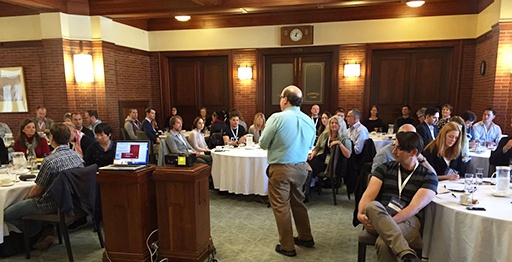
Setup
The 50 or so people who attended were arranged around seven large round tables in the former Members Dining Room, giving plenty of room for note-taking and creature comforts.
It was a mixed group, with some people attending only this masterclass and not the conference proper. At my table, there were state government workers from interstate, local government workers from regional NSW, federal government workers from just down the road and independent contractors who work with government.
At other tables, I could also see some of the conference speakers, taking the opportunity to see what Jared and Dana had to say.
Hands-on
The neat pile of multi-coloured post-it notes, sharpies and paper in each table’s centre indicated we would be doing some hands-on work this day, and so it turned out. Small groups of 2-3 people tackled a task involving writing out positive and negative scenarios for a fictional government application process.
It will probably surprise no-one that we were all much better at thinking up elaborate negative situations that would frustrate the user, but it was also interesting to see how each of those, once identified, could be turned around into a positive state.
As an exercise in identifying user road-blocks and removing them, it was a confidence building process. And, of course, it had us all talking – in our little groups, as a table and then to the whole room.
We’re all trying to do something that actually makes the world better.
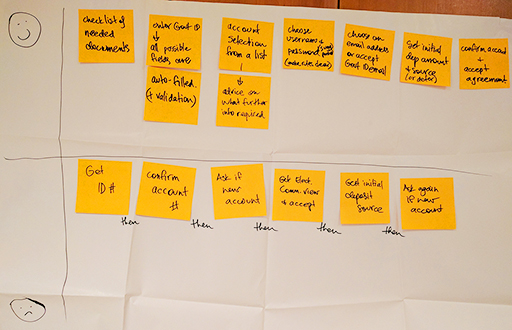
Takeaways
So, after a full day with these two, what did we come away with?
Usability is a neutral experience – to make something usable is simply to remove the obstacles to it being used properly. That is certainly something to aim for, but it won’t create delight in users.
Experience rot – adding more and more features doesn’t improve usability, per se. It can add complexity, frustration and a degenerated user experience.
Delight comes from pleasure, flow and meaning – pleasure can come from a tone of voice, an attitude to users or even just providing complete information that satisfies the user; flow is enhanced when unnecessary steps are removed, letting the user move through a process with as little disruption as possible; meaning comes from delivering information that is authentic, credible, contextual, appropriate and useful. Those are three paths that can separately or collectively lead to user delight.
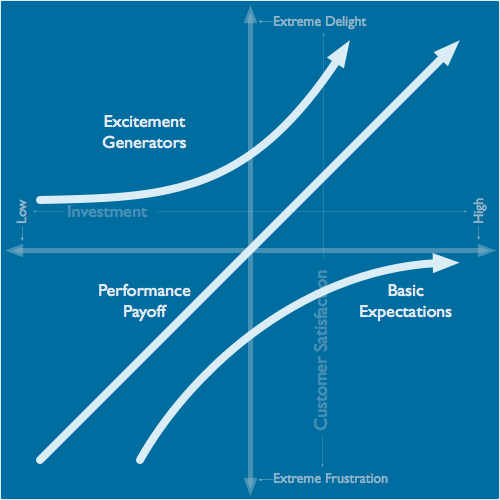
Kano Model – in the 1980s, Japanese customer satisfaction expert Noriaka Kano created a tool for designers based on two axes representing levels of frustration and investment, against which were plotted three influencing forces:
* performance payoff (where greater investment in planning and implementing features leads to user delight)
* basic expectations (functionality that users expect but doesn’t work properly will cause frustration)
* excitement generators (the touches that lift a user experience and create delight)
Innovation is how we get from current experience to aspirations – innovation is not about inventing things; it’s about creating value where it didn’t previously exist.
There was actually a lot more packed into this day – I haven’t touched on the Growth Stages for individual and organisational development (very logical and enlightening), nor have I conveyed how all this information came to us through dozens of anecdotes from real life that illustrated the points being made.
All in all, this was a highly effective masterclass that took us from creating user experiences that simply don’t suck to aiming for experiences that will delight users and drive long term engagement.
Tweets
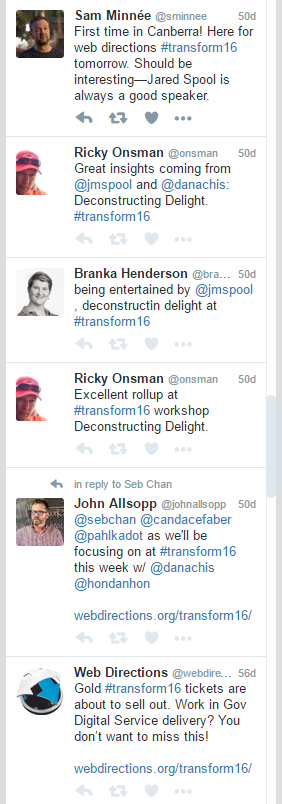
Great reading, every weekend.
We round up the best writing about the web and send it your way each Friday.
